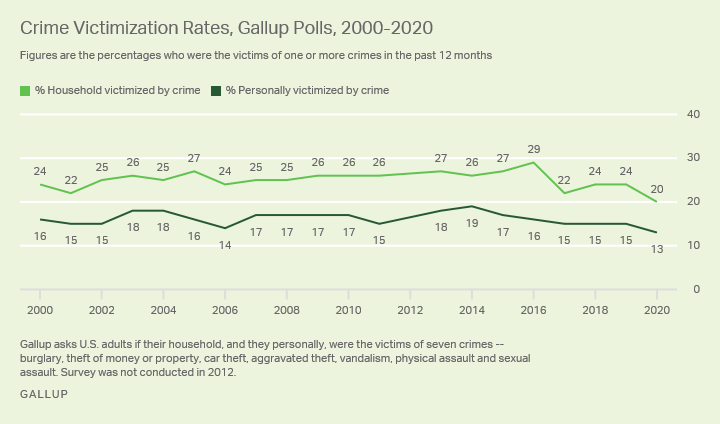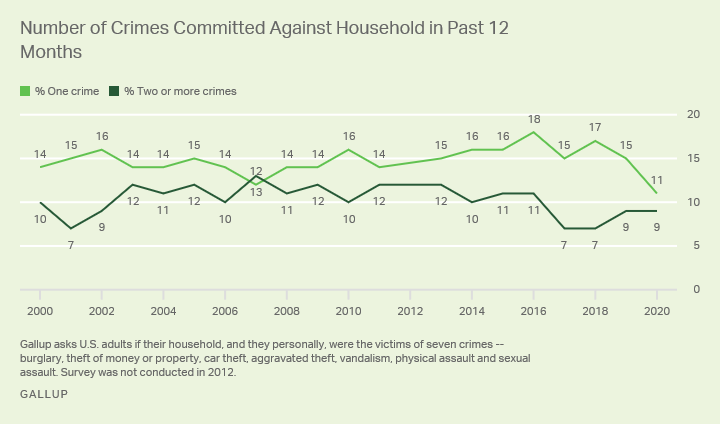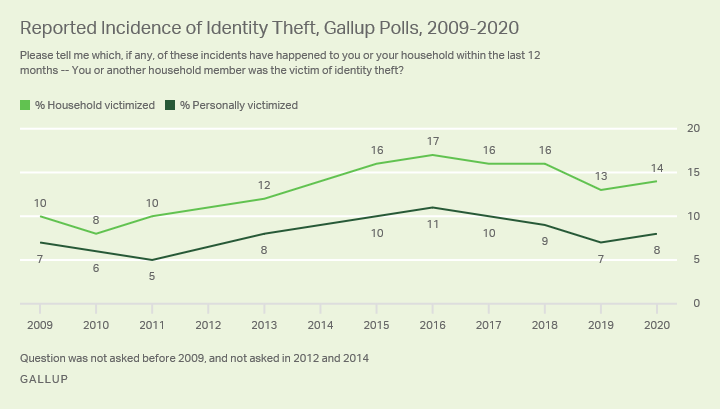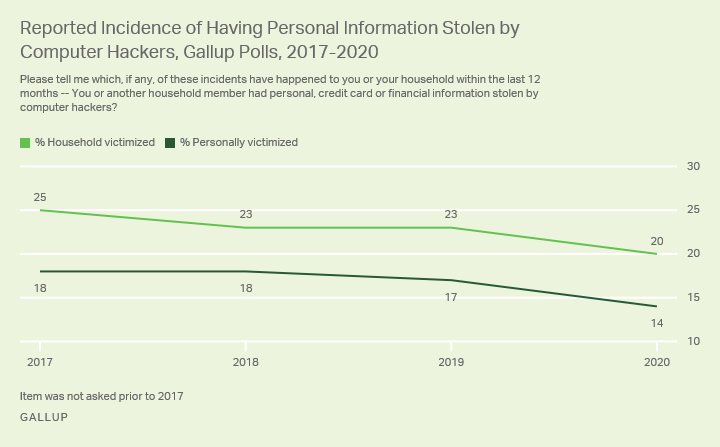Story Highlights
- One in five households, one in eight adults, crime victims in past year
- Both figures are lowest in Gallup's 20-year trend
- Reports of theft, vandalism, burglary have trended down
WASHINGTON, D.C. -- Gallup finds new lows in the percentage of Americans reporting that they, or someone in their household, have been victimized by one of seven different crimes in the past year. Twenty percent of U.S. adults say their household has been the victim of a crime, and 13% say they personally were a victim -- the lowest rates in Gallup's trend, which began in 2000.

Line graph. Twenty percent of U.S. adults say they have been the victim of a crime in the past 12 months, a new low in Gallup's trend. Crime victimization has been lower over the past four years after peaking at 29% in 2016. Thirteen percent say they personally were the victim of a crime, also the lowest. The high was 19% in 2014.
The prior low in reports of household crime victimization, 22%, occurred in 2001, shortly after the 9/11 terrorist attacks, and again in 2017. The high was 29% in 2016, when Americans' self-reports of theft exceeded those in any other year.
Gallup's crime victimization index has been computed annually as part of its Crime poll since 2000, with the exception of 2012. This year's survey was conducted Sept. 30-Oct. 15.
Gallup asks the public whether they or a member of their household experienced each of seven crimes in the past year: burglary, property theft, car theft, vandalism, aggravated theft, physical assault and sexual assault.
The reported incidence of these crimes varies from a low of 1% for aggravated theft (money or property stolen from them by force or threat of force) to a high of 12% for simple theft. All are at or near the low points in Gallup's trend, with reports of simple theft down five percentage points from its 2016 high and vandalism down four points from its 2015 high.

Series of line graphs showing incidence of crimes in the U.S. in the past 12 months. Currently, 2% say their house or apartment was broken into. Twelve percent say money or property was stolen from them or another member of their household. Two percent say a car owned by them or another household member was stolen. Eleven percent say a home, car or property owned by them or another household member was vandalized. One percent say money or property was taken from them or another household member by force, with a gun, knife, weapon or physical attack, or threat of force. Three percent say they or another member of their household was mugged or physically assaulted. Two percent say they or another household member was sexually assaulted.

Line graph. Eleven percent of Americans report that someone in their household was victimized by one crime in the past 12 months, and 9% report members of their household were victims of two or more crimes. In most past years, there has been a wider gap between these two groups, with significantly more saying they were the victim of one crime than the victim of two or more.
Household Crime Victimization Drops Among City, Rural Residents
Crime victimization has fallen more among certain types of households than others -- comparing this year's rates with the ones from 2018 and 2019 combined, when an average of 24% of Americans reported someone in their household was victimized.
-
City residents (down six points) and town or rural residents (down four points) show notable declines, while suburban residents do not.
-
Those living in the West show a greater drop than those in other regions of the country, with less change in the South.
-
Americans in lower-income households show a six-point drop, compared with five points among those in middle-income households and three points in upper-income households.
| 2018-2019 | 2020 | Change | ||||||||||||||||||||||||||||||||||||||||||||||||||||||||||||||||||||||||||||||||||||||||||||||||||
|---|---|---|---|---|---|---|---|---|---|---|---|---|---|---|---|---|---|---|---|---|---|---|---|---|---|---|---|---|---|---|---|---|---|---|---|---|---|---|---|---|---|---|---|---|---|---|---|---|---|---|---|---|---|---|---|---|---|---|---|---|---|---|---|---|---|---|---|---|---|---|---|---|---|---|---|---|---|---|---|---|---|---|---|---|---|---|---|---|---|---|---|---|---|---|---|---|---|---|---|---|
| % | % | pct. pts. | ||||||||||||||||||||||||||||||||||||||||||||||||||||||||||||||||||||||||||||||||||||||||||||||||||
| U.S. households | 24 | 20 | -4 | |||||||||||||||||||||||||||||||||||||||||||||||||||||||||||||||||||||||||||||||||||||||||||||||||
| Place of residence | ||||||||||||||||||||||||||||||||||||||||||||||||||||||||||||||||||||||||||||||||||||||||||||||||||||
| Big/Small city | 28 | 22 | -6 | |||||||||||||||||||||||||||||||||||||||||||||||||||||||||||||||||||||||||||||||||||||||||||||||||
| Suburb of big/small city | 23 | 22 | -1 | |||||||||||||||||||||||||||||||||||||||||||||||||||||||||||||||||||||||||||||||||||||||||||||||||
| Town/Rural area | 20 | 16 | -4 | |||||||||||||||||||||||||||||||||||||||||||||||||||||||||||||||||||||||||||||||||||||||||||||||||
| Region | ||||||||||||||||||||||||||||||||||||||||||||||||||||||||||||||||||||||||||||||||||||||||||||||||||||
| East | 23 | 20 | -3 | |||||||||||||||||||||||||||||||||||||||||||||||||||||||||||||||||||||||||||||||||||||||||||||||||
| Midwest | 23 | 18 | -5 | |||||||||||||||||||||||||||||||||||||||||||||||||||||||||||||||||||||||||||||||||||||||||||||||||
| South | 23 | 22 | -1 | |||||||||||||||||||||||||||||||||||||||||||||||||||||||||||||||||||||||||||||||||||||||||||||||||
| West | 28 | 20 | -8 | |||||||||||||||||||||||||||||||||||||||||||||||||||||||||||||||||||||||||||||||||||||||||||||||||
| Annual household income | ||||||||||||||||||||||||||||||||||||||||||||||||||||||||||||||||||||||||||||||||||||||||||||||||||||
| Less than $40,000 | 30 | 24 | -6 | |||||||||||||||||||||||||||||||||||||||||||||||||||||||||||||||||||||||||||||||||||||||||||||||||
| $40,000-<$100,000 | 23 | 18 | -5 | |||||||||||||||||||||||||||||||||||||||||||||||||||||||||||||||||||||||||||||||||||||||||||||||||
| $100,000 or more | 23 | 20 | -3 | |||||||||||||||||||||||||||||||||||||||||||||||||||||||||||||||||||||||||||||||||||||||||||||||||
| Gallup asks U.S. adults if their household was the victims of seven crimes in the past 12 months -- burglary, theft of money or property, car theft, aggravated theft, vandalism, physical assault and sexual assault. | ||||||||||||||||||||||||||||||||||||||||||||||||||||||||||||||||||||||||||||||||||||||||||||||||||||
| Gallup | ||||||||||||||||||||||||||||||||||||||||||||||||||||||||||||||||||||||||||||||||||||||||||||||||||||
Rates of personal crime victimization are down more modestly since 2018 (two points, from 15% to 13%) than household victimization is. Crime victimization has not declined among young adults, non-White adults and men in the past year, but has dropped among middle-aged and older adults, White adults and women. There has been a pronounced drop among parents of minor children, from 18% to 11%.
| 2018-2019 | 2020 | Change | ||||||||||||||||||||||||||||||||||||||||||||||||||||||||||||||||||||||||||||||||||||||||||||||||||
|---|---|---|---|---|---|---|---|---|---|---|---|---|---|---|---|---|---|---|---|---|---|---|---|---|---|---|---|---|---|---|---|---|---|---|---|---|---|---|---|---|---|---|---|---|---|---|---|---|---|---|---|---|---|---|---|---|---|---|---|---|---|---|---|---|---|---|---|---|---|---|---|---|---|---|---|---|---|---|---|---|---|---|---|---|---|---|---|---|---|---|---|---|---|---|---|---|---|---|---|---|
| % | % | pct. pts. | ||||||||||||||||||||||||||||||||||||||||||||||||||||||||||||||||||||||||||||||||||||||||||||||||||
| U.S. adults | 15 | 13 | -2 | |||||||||||||||||||||||||||||||||||||||||||||||||||||||||||||||||||||||||||||||||||||||||||||||||
| Gender | ||||||||||||||||||||||||||||||||||||||||||||||||||||||||||||||||||||||||||||||||||||||||||||||||||||
| Men | 14 | 13 | -1 | |||||||||||||||||||||||||||||||||||||||||||||||||||||||||||||||||||||||||||||||||||||||||||||||||
| Women | 16 | 12 | -4 | |||||||||||||||||||||||||||||||||||||||||||||||||||||||||||||||||||||||||||||||||||||||||||||||||
| Race | ||||||||||||||||||||||||||||||||||||||||||||||||||||||||||||||||||||||||||||||||||||||||||||||||||||
| White adults | 14 | 11 | -3 | |||||||||||||||||||||||||||||||||||||||||||||||||||||||||||||||||||||||||||||||||||||||||||||||||
| Non-White adults | 16 | 16 | 0 | |||||||||||||||||||||||||||||||||||||||||||||||||||||||||||||||||||||||||||||||||||||||||||||||||
| Age | ||||||||||||||||||||||||||||||||||||||||||||||||||||||||||||||||||||||||||||||||||||||||||||||||||||
| 18-34 years | 18 | 21 | +3 | |||||||||||||||||||||||||||||||||||||||||||||||||||||||||||||||||||||||||||||||||||||||||||||||||
| 35-54 years | 16 | 11 | -5 | |||||||||||||||||||||||||||||||||||||||||||||||||||||||||||||||||||||||||||||||||||||||||||||||||
| 55+ years | 13 | 8 | -5 | |||||||||||||||||||||||||||||||||||||||||||||||||||||||||||||||||||||||||||||||||||||||||||||||||
| Parent of children under age 18 | ||||||||||||||||||||||||||||||||||||||||||||||||||||||||||||||||||||||||||||||||||||||||||||||||||||
| Yes | 18 | 11 | -7 | |||||||||||||||||||||||||||||||||||||||||||||||||||||||||||||||||||||||||||||||||||||||||||||||||
| No | 13 | 13 | 0 | |||||||||||||||||||||||||||||||||||||||||||||||||||||||||||||||||||||||||||||||||||||||||||||||||
| Gallup asks U.S. adults if they personally were the victims of seven crimes in the past 12 months -- burglary, theft of money or property, car theft, aggravated theft, vandalism, physical assault and sexual assault. | ||||||||||||||||||||||||||||||||||||||||||||||||||||||||||||||||||||||||||||||||||||||||||||||||||||
| Gallup | ||||||||||||||||||||||||||||||||||||||||||||||||||||||||||||||||||||||||||||||||||||||||||||||||||||
Internet Crime Also Lower Than in Recent Years
In addition to measuring the incidence of physical and property crime, Gallup has more recently added items that assess the extent to which Americans have been victimized by internet crimes. The internet items are not included in the crime victimization index to allow for longer historical comparisons.
Generally speaking, Americans are more likely to report that they or another household member has been victimized by internet crimes than by conventional crimes, including 14% who report being victimized by identity theft and 20% reporting theft of personal, credit-card or financial information by computer hackers.
Current reports of identity theft for households are similar to the 13% measured in 2019 but lower than the average 16% between 2015 and 2018. Still, current reports of identity theft remain higher than they were between 2009 and 2013, when an average of 10% reported being victimized by it.
The percentage of individuals who say they have been victimized by identity theft -- currently 8% -- follows the same general pattern Gallup has seen in recent years.

Line graph. Fourteen percent of U.S. adults currently say a member of their household has been the victim of identity theft in the past 12 months. Eight percent say this has happened to them personally.
Reports of theft of personal, credit card or financial information are also down from where they were previously -- the 20% who say they or someone in their household has been victimized compares with an average 24% in 2017 through 2019.
Fourteen percent of U.S. adults say they personally have had personal or financial information stolen by computer hackers, also down four points from the average over the prior three years.

Line graph. Twenty percent of U.S. adults currently say a member of their household has had personal, credit card or financial information stolen by computer hackers in the past 12 months. Fourteen percent say this has happened to them personally.
Implications
The coronavirus pandemic has had wide-ranging effects on public health, the economy, education, and possibly crime as well. While the crime rate had already been trending down in recent years, Americans' reports of crime victimization have hit a 20-year low at a time of social distancing and reduced economic activity as people attempt to reduce their exposure to COVID-19.
The Gallup data give an early indication of present U.S. crime rates, with larger-scale government surveys reporting data on a lagged basis. Like the Gallup survey, those surveys had reported a decline in crime in recent years, but their reports on 2020 data will not be out until sometime in 2021.
View complete question responses and trends (PDF download).
Learn more about how the Gallup Poll Social Series works.




